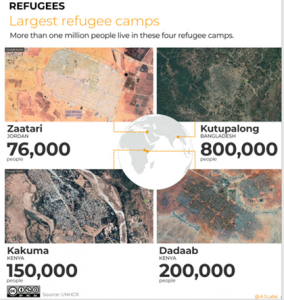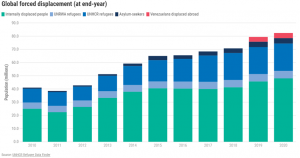Global refugee crisis explained in five graphics
The latest UNHCR report ‘Global Trends, Forced Displacement in 2020’ paints an alarming picture of the numbers of people forced to flee their homes because of conflict or persecution.
The report says there are now 82.4 million people displaced around the world.
 Thirty million of these are refugees, another 48 million are displaced within their own country and 4.1 million are asylum-seekers. Almost half are children.
Thirty million of these are refugees, another 48 million are displaced within their own country and 4.1 million are asylum-seekers. Almost half are children.
More than half, or 55 percent of refugees, come from three countries: Syria, Palestine and Venezuela.
The report says Africa accounts for more than one-third of the world’s displaced people. By the end of 2020, at least 30.6 million people were displaced across the continent.
Last year, nearly 60,000 refugees fled from Ethiopia to neighbouring countries following violence in several parts of the East African country. In November 2020, fighting broke out in Ethiopia’s northern Tigray region displacing more than one million people according to the International Organisation for Migration (IOM).
 In the Middle East, Syrian refugees continued to flee their country’s 10-year-long war, with nearly 134,000 recorded to have left in 2020. Half of them (65,000) fled to neighbouring Turkey, which now hosts the world’s largest refugee community at 3.7 million people. During the year, nearly a quarter of Syrian refugees (32,500) reached Germany.
In the Middle East, Syrian refugees continued to flee their country’s 10-year-long war, with nearly 134,000 recorded to have left in 2020. Half of them (65,000) fled to neighbouring Turkey, which now hosts the world’s largest refugee community at 3.7 million people. During the year, nearly a quarter of Syrian refugees (32,500) reached Germany.
In Latin America, nearly 400,000 refugees fled Venezuela following a political and economic crisis in the country. Of these, 139,000 were recorded fleeing to Peru, 80,000 to the Dominican Republic and 60,000 to Brazil.
In Asia, the UNHCR recorded at least 29,000 refugees from Myanmar. Nearly all of these refugees arrived in neighbouring India (17,000) and Bangladesh (12,000).
 In Europe, at least 89,000 refugees fled from Azerbaijan to Armenia following 44 days of fighting that broke out between Armenian and Azerbaijani forces in the disputed territory of Nagorno-Karabakh.
In Europe, at least 89,000 refugees fled from Azerbaijan to Armenia following 44 days of fighting that broke out between Armenian and Azerbaijani forces in the disputed territory of Nagorno-Karabakh.
Across the Atlantic, during 2020, the United States received 8,500 refugees from 20 countries. Nearly half of these refugees came from only three countries: Venezuela (1,600), El Salvador (1,200), and Guatemala (1,100). This is significantly lower than in 2019 when the country received 32,000 refugees and as many as 85,000 in 2015.
 Canada received 7,500 refugees from 21 countries in 2020. The top countries of origin were Nigeria (1,400), Iran (1,200) and Hungary (629). According to UNHCR figures, Australia received just 956 refugees in 2020 – mostly from Iran.
Canada received 7,500 refugees from 21 countries in 2020. The top countries of origin were Nigeria (1,400), Iran (1,200) and Hungary (629). According to UNHCR figures, Australia received just 956 refugees in 2020 – mostly from Iran.
During the COVID-19 pandemic, “everything else has stopped, including the economies, but wars and conflict and violence and discrimination and persecution, all the factors that pushed these people to flee, have continued,” UNHCR chief Filippo Grandi said.
In 2020, 1.27 million more people from 64 countries became refugees.
 These five graphics show the scale of the displacement crisis, the desperate journeys many refuges have taken and the recent history of human displacement.
These five graphics show the scale of the displacement crisis, the desperate journeys many refuges have taken and the recent history of human displacement.
Read the full UNHCR report here: https://www.unhcr.org/flagship-reports/globaltrends/












